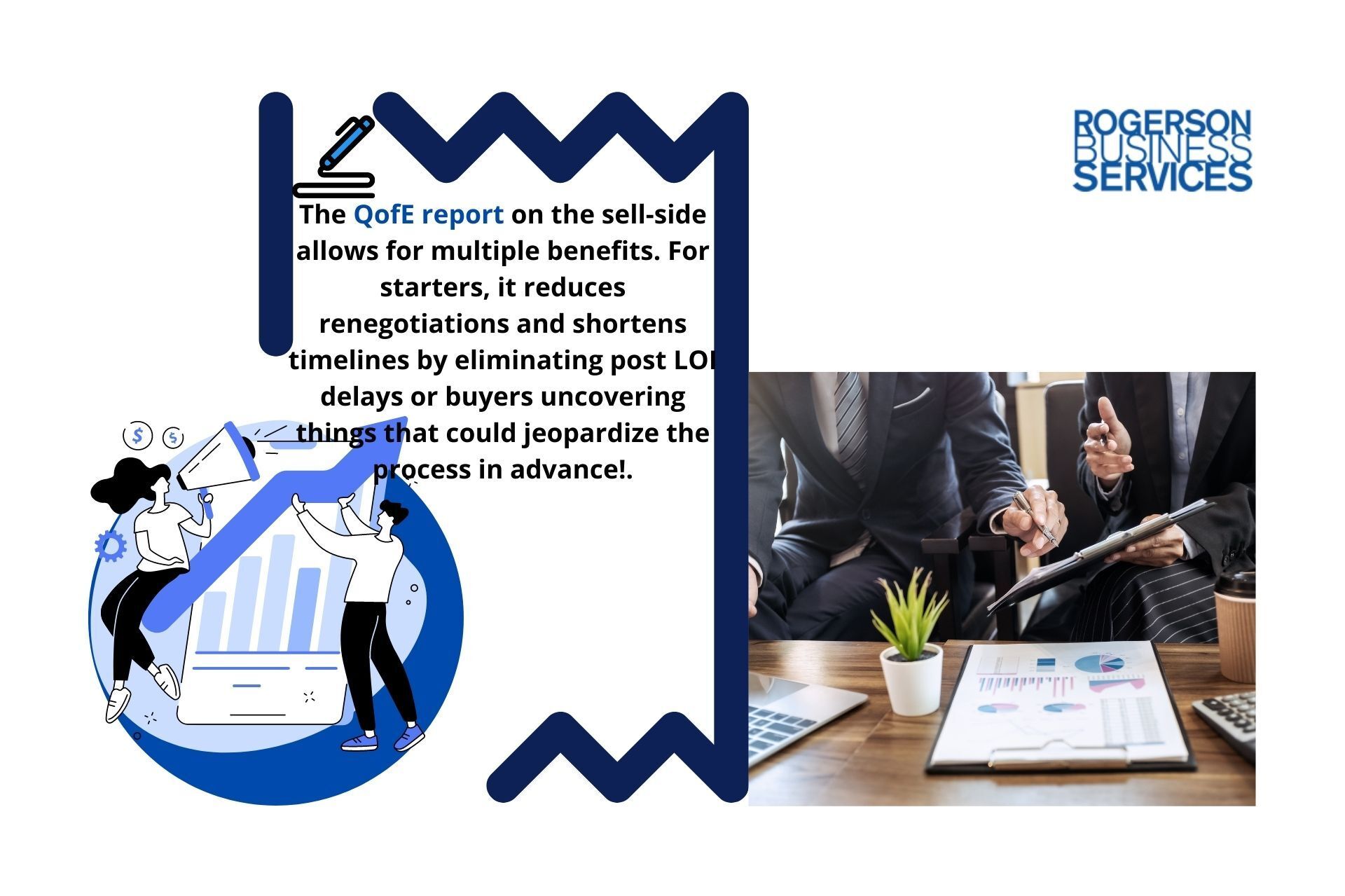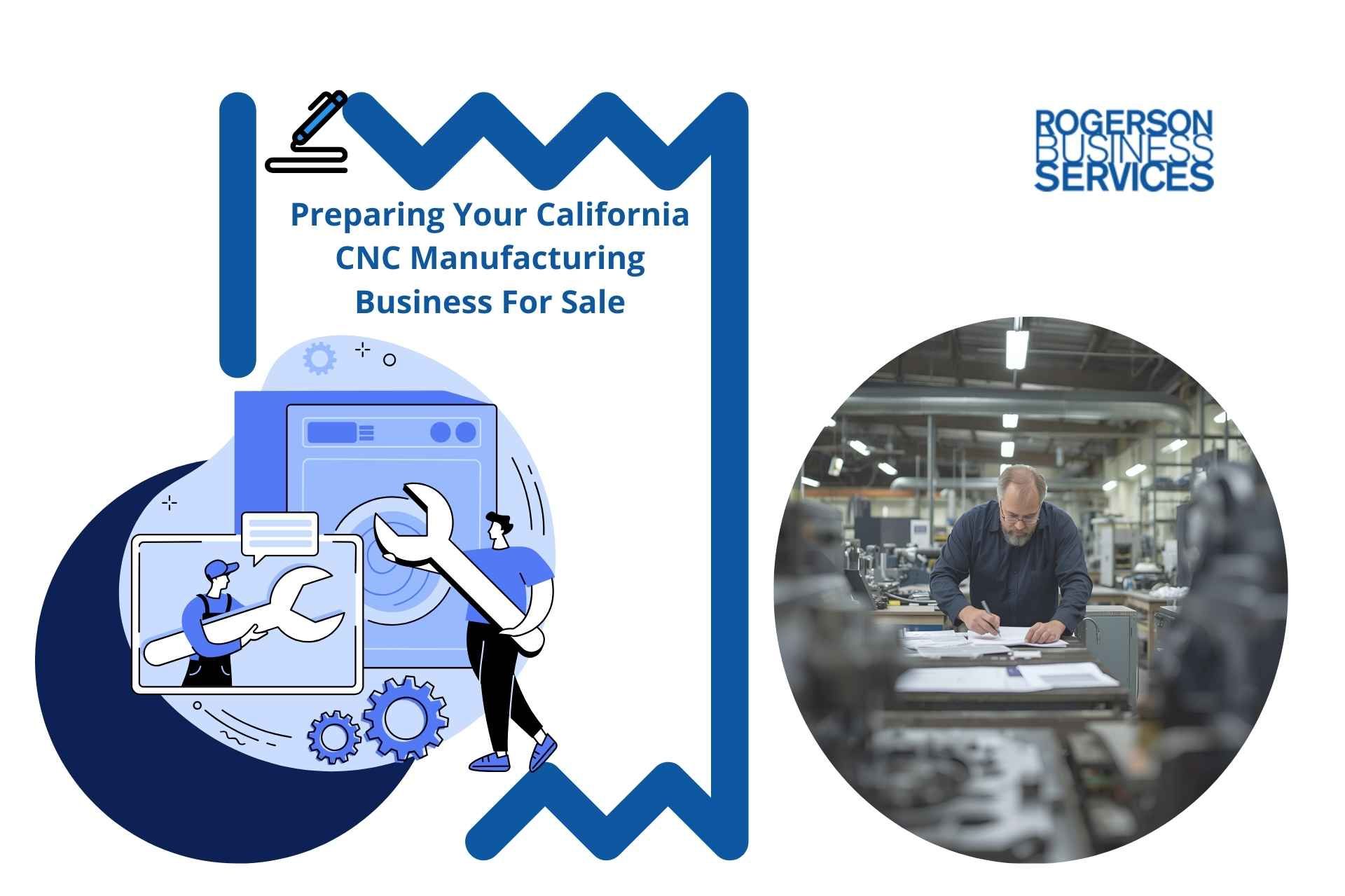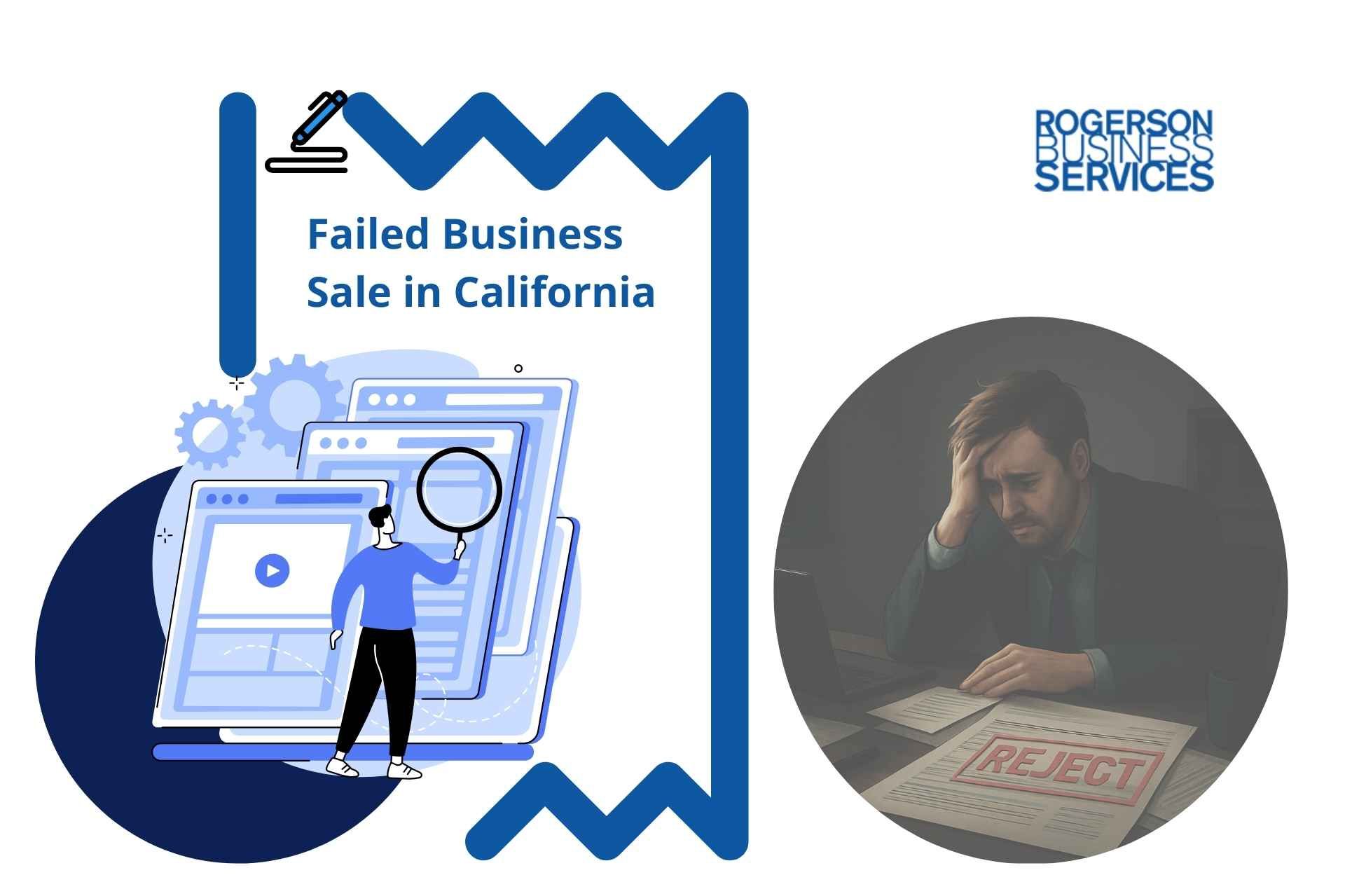Quality of Earnings Report: Sell-Side Due Diligence in California
Quality of Earnings Report
The QofE report on the sell-side allows for multiple benefits. For starters, it reduces renegotiations and shortens timelines by eliminating post LOI delays or buyers uncovering things that could jeopardize the process in advance!

Providing buyers with a quality earnings report that details analyses on prospective acquisitions allow lower middle market business owners in California to deliver an in-depth sell-side due diligence report that could avoid a drawn-out transaction and help you address any concerns before they arise.
First Things First: What is a Quality of Earnings Report?
A QofE report establishes a business’s value by analyzing and reporting the detailed aspects that an investor, buyer, or seller may not identify when reviewing financial statements. When selling a lower middle market business, the report is called a sell-side QofE but known as a buy-side QofE when investing or buying a business in California.
Baby boomers business owners in California understand that this report is handy in the due diligence of selling a business to potential buyers.
The quality of the earnings report outlines the impact of items that do not reflect a business’ cash flow or performance.
For sellers, the report will uncover any details that could derail a future sale. For instance, if you’re the lower middle market business CEO, you probably understand every detail in the financial statements. However, the sell-side report helps you understand the same business from an investor’s or buyer’s perspective.
This two-sided viewpoint lets the seller take remedial actions necessary before the sale.
Sample Quality of Earnings Report
Quality of earnings reports should include a business’s net income; net sales, revenue, earnings before interest and taxes; earnings per share (EPS); and earnings from existing operations. Investors can analyze these reports and gauge the company's financial health to determine whether it would be a worthwhile investment.
For example, if you’re a seller, selling your manufacturing business, who doesn’t have enough experience with transactions, there might be unnoticeable confusion around the working capital. In such an instance, you may think that the manufacturer sales will provide proceeds equivalent to the receivables and purchase price, which isn’t always the case since you don’t retain inventories or receivables in most transactions.
Quality of Earning Reports
Assume Company X’s net income for the financial year 2018 rose by 80 percent. This growth resulted from sales that increased by 150 percent, as well as reduced administrative expenses of 10 percent compared to the previous year.
Similarly, company Z had a net income increase of 130 percent for the financial year 2019. While the sales remained nearly the same and the expenses rose less than 5 percent, the company implemented a strategic change which led to a significant alteration in the manner of its asset and inventory depreciation. Company Z’s assumed growth is, therefore, attributable to changes in the manner of asset depreciation.
By comparing these two companies with the same growth rate in the financial year 2019, we can deduce that company X has a better quality of earnings than company Z. This is because company X’s rise in net income results from a core operation improvement, which is product sales.
Even though company Z had a similar net increase, the reported growth is attributed to a change in the accounting process: the altered calculation of depreciation. Thus, the paper profits will be much less than the earnings increase reported by the company. While company Z’s operation to increase the net income is acceptable, its QofE is lower than company X.
Know the Benefits of the QofE Report
There are multiple benefits of conducting a QofE report on the sell-side due diligence stage when selling a lower middle market business in California. For starters, it reduces the chances of price renegotiations in the future. The report also shortens the timeline of the deal by eliminating post-LOI or letter of intent delays and removing the risk of buyers uncovering things that could jeopardize the process.
Additionally, conducting a QofE report increases the likelihood of accounting for the extrinsic and intrinsic elements of value. It also gives you a positioning, allowing qualified buyers to see your business’s hidden value and understand its competitive edge in the marketplace.
Earnings Quality Ratio
The earnings quality ratio is a metric that measures how well a company's net income meets quality standards. The ratio is calculated by taking the cash generated from operating activities and dividing them by net income. Rather than providing an absolute amount, this approach provides the QofE ratio.
Cash Flows from Operations
Net Income
Therefore, net cash from operations divided by net income equals the quality of earnings ratio. Analysts prefer using the cash flow statement to calculate the net cash from operations and the income statement to calculate net income. Although quality is subjective, profits are typically deemed of excellent quality when they are any of the following:
- Consistent and predictable even in the long-term
- Exclude non-recurring and special cost items
- Backed up by operating cash flows
- Non-recurring and special cost items using relevant accounting standards
- Operating cash flows are the backbone of the company.
Interpretation of the Ratio
When the ratio is less than one
A ratio less than 1 means that the company's net income exceeds its operating cash flows. It suggests that this company probably employs accounting techniques that inflate its net income. This also indicates a low quality of earnings.
When the ratio is greater than one
A ratio is greater than 1 means that the company's net income does not exceed its operating cash flows. It suggests that this company does not employ accounting techniques that inflate its net income. This also indicates a high quality of earnings.
How to Read a Quarterly Report
Quarterly reports are indicators that show the quarterly progress of the company. To read and understand these reports, you will need to know the items it contains:
- Quarterly Revenues: The amount of money earned in the course of the quarter-year period. Many investors focus on this cost item, especially when the economy of that company is lagging.
- Quarterly Expenses: The money the company spent carrying out business activities during the quarterly period.
- Quarterly Profits: Sometimes known as net income or bottom-line earnings. The amount that remains after subtracting expenses from revenues. Notably, if the quarterly report shows losses instead of profits, it might scare off investors who interpret the loss as a red flag.
- Quarterly Earnings Per Share (EPS): The firm's earnings per share of stock. Stock shares tend to be very dynamic, and companies tend to buy them and sell them to investors. The metric, therefore, considers these factors significantly.
- Quarterly Estimates: Analysts will use phrases like "missed estimates" when citing how poorly or how well a company is performing over the quarterly period. This cost item looks forward and includes metrics like sales, revenues, and EPS.
Gauging the Quality of Earnings
Tracking operations from financial statements to cash flow statements can help you determine the quality of earnings. Analysts are more concerned about net income and use it as a reference point in determining how well a lower middle market company in California is functioning. When the current income exceeds the previous year’s income, this is considered a good sign.
Other financial items that help gauge the quality of earnings are nonrecurring and one-time items, reserve balances, transparency in disclosures, disclosure of related transactions, assumptions made, and consistency in meeting the accounting policies and standards.
However, the quality of profits shows how dependable these figures are. An analyst will review the income statement by going through every detail and item on it. For example, a company’s sales growth could be due to lenient lending terms. Lower middle market business brokers or an analyst looks through the cash flow and balance sheet statements to learn more about them.
Interpreting Quality of Earnings
A firm can continuously generate high-quality results. In doing so, the management should detail all earning sources in the earnings report. It should also state what changes if any, the company anticipates in the sources. The company should appropriately identify expenses and ensure that income is not unduly inflated. In other words, the better the quality of earnings, the closer the company adheres to GAAPs (generally accepted accounting principles).
The middle market business broker in California will look for further variations when they notice that the company has high net incomes and negative cash flows. Other factors besides sales can contribute to increasing revenue. If this is the case, the analyst will analyze the cash flow statements.
Notably, non-recurring incomes or one-time transactions are other metrics that the analyst will evaluate. For instance, a company can postpone its debt expense when it arranges for a future balloon payment. The current period's net income will be higher due to this agreement, but investors may be concerned.
Why Perform a QofE?
The purpose of a QofE is to revise the reported earnings before interest, taxes, depreciation, and amortization (EBITDA). The revised EBITDA should reflect the company’s current situation over time. It should also include a comparison of EBITDA that has been adjusted over the last 2-3 years. A QofE has significant impacts on a company’s valuation for 3 main reasons:
- An investor or buyer relies on the adjusted EBITDA as the valuation basis.
- The adjusted EBITDA and revenue form the basis of the forecasts.
- The adjusted revenue helps recalculate an effective growth rate.
With this in mind, baby boomers business owners must develop an accurate picture of their company's adjusted revenue and EBITDA. Unfortunately, many founders remain unfamiliar with the concept of QofE throughout an M&A transaction, resulting in some values being neglected or left outside the business valuation process. This breakdown tries to make sure you're not the kind of founder who is unaware of the sell-side M&A process.
With this knowledge, you will always be prepared to discuss the company's valuation from an all-around perspective, whether you are doing so with your investors or your buyers. And when you are in the seller's shoes, you will always have the additional advantage of perceiving what a seasoned buyer or investor thinks.
What are Low-Quality Earnings?
If a company reports an ever-increasing profit margin due to cost reductions or higher sales, it is considered to be having high-quality earnings. Increased sales from marketing campaigns are also indicative of higher-quality earnings.
If, on the other hand, the shift in a company's earnings is attributable to external sources, the company is said to have low-quality earnings. The following reasons can be blamed for low-quality earnings:
- Increase in the prices of commodities
- Inflation
- Eliminating important inventory layers like LIFO (last-in, first-out)
- Profit generated from selling an asset
- Aggressive application of the required accounting standards
- An increasing net income that corresponds to an increased cash flow
How to Build your QofE
When building your quality of earnings, the first thing to do is automatically link everything you hear or read to potential QofE adjustments. Keep thinking about how items or events qualify for adjustments and how they impact your company's financial statements overall.
For instance, if an event or item impacted revenue, consider its impact on costs. Was the effect equal in both ways? Ensure that another accounting entry had not previously offset the to-be-adjusted costs and that it has no impacts on the company's earnings before interest, taxes, depreciation, and amortization (EBITDA).
Additionally, you ought to quantify each adjustment most objectively and rationally. While this seems doable, it may sometimes be impossible to be accomplished, and therefore, you might need to develop a range. Last but not least, when building your QofE, ensure that the cost you adjust for had previously been classified above the earnings before interest, taxes, depreciation, and amortization (EBITDA).
For investors, the high-quality earnings of a company matter a lot. That is because, if a company currently shows high profits, the same positive increment is likely to reoccur in its future. This is a positive sign that signifies that the company will have more cash flows, lower investments risks, and higher stock prices.
If you want to successfully sell your lower middle market business in 2022, the solution is to get an experienced professional who will help you with the sell-side M&A process. Hiring a lower middle market business broker can be a wise decision to help you successfully value and sell your business in California at the highest price.
Conclusion
If you are a retiring business owner looking to exit your lower middle market business in California, here are five tips to get you started:
1. Don't wait until the last minute to start planning your exit. The process of selling a lower middle market business can take a long time, so it's important to start early.
2. Have a clear idea of what you want to get out of the sale. Know your goals and what you're willing to negotiate.
3. Choose the right type of buyer. Not all buyers are created equal, so do your research and find the right one for your business.
4. Be prepared for a lot of due diligence. M&A buy-side due diligence is when buyers will want to know everything about your business, so be ready to provide documentation and answer questions. See why you can increase the chance of selling your business by obtaining a QoE analysis report.
5. Be flexible with the terms and conditions of the deal. It's important to be open to negotiation to get the best possible deal for your business.
Rogerson Business Services, also known as, California's lower middle market business broker is a sell-side M&A advisory firm that has closed hundreds of lower middle-market deals in California. We are dedicated to helping our clients maximize value and achieve their desired outcomes.
We have a deep understanding of the Californian market and an extensive network of buyers, which allows us to get the best possible price for our clients. We also provide comprehensive support throughout the entire process, from initial valuation to post-closing integration.
Our hands-on approach and commitment to our client's success set us apart from other firms in the industry. If you consider selling your lower middle market business, we would be honored to help you navigate the process and realize your goals.
If you have decided to value and then sell your lower middle market business or still not ready, get started here, or call toll-free 1-844-414-9600and leave a voice message with your question and get it answered within 24 hours. The deal team is spearheaded by Andrew Rogerson, Certified M&A Advisor, he will personally review and understand your pain point/s and prioritize your inquiry with Rogerson Business Services,
RBS Advisors.
This is part of business valuation methods to answer what's my company worth series ->
Hey there! Can we send you a gift?
We just wanted to say hi and thanks for stopping by our little corner of the web. :) we'd love to offer you a cup of coffee/tea, but, alas, this is the Internet.
However, we think you'll love our email newsletter about building value and properly position your company before transition/exit your business ownership.
As a special welcome gift for subscribing, you'll also get our helping and educational guides, tips, tutorials, etc.. for free.
It's filled with the best practices for retiring serial business owners like Dan Gilbert, Larry Ellison, Warren Buffett, and many more.
Just sign up for our emails below.


